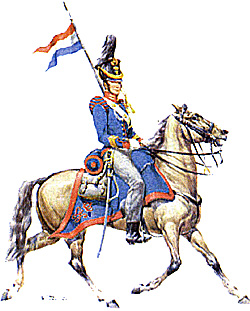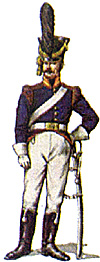
History
The Netherlands 'Korps Guides te Paard' was erected by Decree No. 108 dating 18 February 1815, and composed of (North-Netherlandish) troopers from the cavalry and horse artillery. Its duty was not that of bodyguard to the Prince of Orange, as sometimes is stated, rather the troopers were divided among the staffs and headquarters of the Netherlandish troops, to be used as dispatch-riders. They never operated as a unit, and as far as I know no members of the Guides participated in any real fighting at the battles of Quatre-Bras or Waterloo. I also could find no killed or wounded Guides in the reports of the Netherlands losses. During the Waterloo campaign the Guides had a strength of 67 men and 70 horses (strength of 12 June 1815) and were commanded by Captain C.A.S. Baron von Heinecken.
On 4 December 1819 the Korps Guides te Paard was disbanded and its men incorporated in the Regiment Lansiers (Lancers) No. 10.
Uniform
Although on formation on 18 February a uniform was decreed for the Guides, it is very doubtful if it was worn during the Waterloo campaign, taking in account the short period of its existence, the fact that the men already had a uniform because they came from the cavalry or horse artillery, and the fact that resources were limited and uniforms were needed more by other units at that time. However, the uniform that was decreed was as follows:
 Dark blue,
shorttailed, single-breasted coat of the same cut as for the
carabiniers. Red collar, cuffs, turnbacks and piping. Blue
wings with red lace on both shoulders. Two 'stripes' of
yellow lace on each side of the collar. Yellow buttons. White
waistcoat. White trousers or grey overalls.. Short hussar
boots. The same cylindrical shako as was worn by the horse
artillery, with a crowned 'W' cipher in brass, and yellow
cords Black panache of cock feathers (On 4 December 1817
the panache of cock feathers was replaced by one of
horsehair). Dark blue greatcoat. White shoulder belt across
the left shoulder, and a white waist belt with brass clasp.
White gloves.
Dark blue,
shorttailed, single-breasted coat of the same cut as for the
carabiniers. Red collar, cuffs, turnbacks and piping. Blue
wings with red lace on both shoulders. Two 'stripes' of
yellow lace on each side of the collar. Yellow buttons. White
waistcoat. White trousers or grey overalls.. Short hussar
boots. The same cylindrical shako as was worn by the horse
artillery, with a crowned 'W' cipher in brass, and yellow
cords Black panache of cock feathers (On 4 December 1817
the panache of cock feathers was replaced by one of
horsehair). Dark blue greatcoat. White shoulder belt across
the left shoulder, and a white waist belt with brass clasp.
White gloves.
Armament
Consisted of a curved hussar sabre with blank metal scabbard, brass hilt and white sabre knot, and two pistols. On 17 September 1815 the armament was augmented by a lance of Austrian pattern with a three-coloured pennon; red over white over blue. NCO's wore one or two chevrons, according to their rank. The troopers wore the rank distinctions of a corporal.
Horse furniture was the same as for the light dragoons, with black leather and brass fittings. Dark blue pointed shabraque with wide red edging and in the points a crowned 'W' cipher in red. Dark blue portmanteau with red edging. Leather saddlebags at the back of the saddle behind the rider.
Sources:
F. Forbes Wels: "De Nederlandse Cavalerie" (Bussum
1963).
F.J. G. ten Raa: "De uniformen van de
Nederlandsche Zee- en Landmacht hier te lande en
in de koloniln" ('s Gravenhage 1900).
W.E.A. Wapperman: "De vorming van het
Nederlandsche leger na de omwenteling van 1813
en het aandeel van dat leger aan den veldtocht
van 1815" (Breda 1900).
Back to Table of Contents -- Age of Napoleon #31
Back to Age of Napoleon List of Issues
Back to MagWeb Master Magazine List
© Copyright 1999 by Partizan Press.
This article appears in MagWeb (Magazine Web) on the Internet World Wide Web. Other military history articles and gaming articles are available at http://www.magweb.com